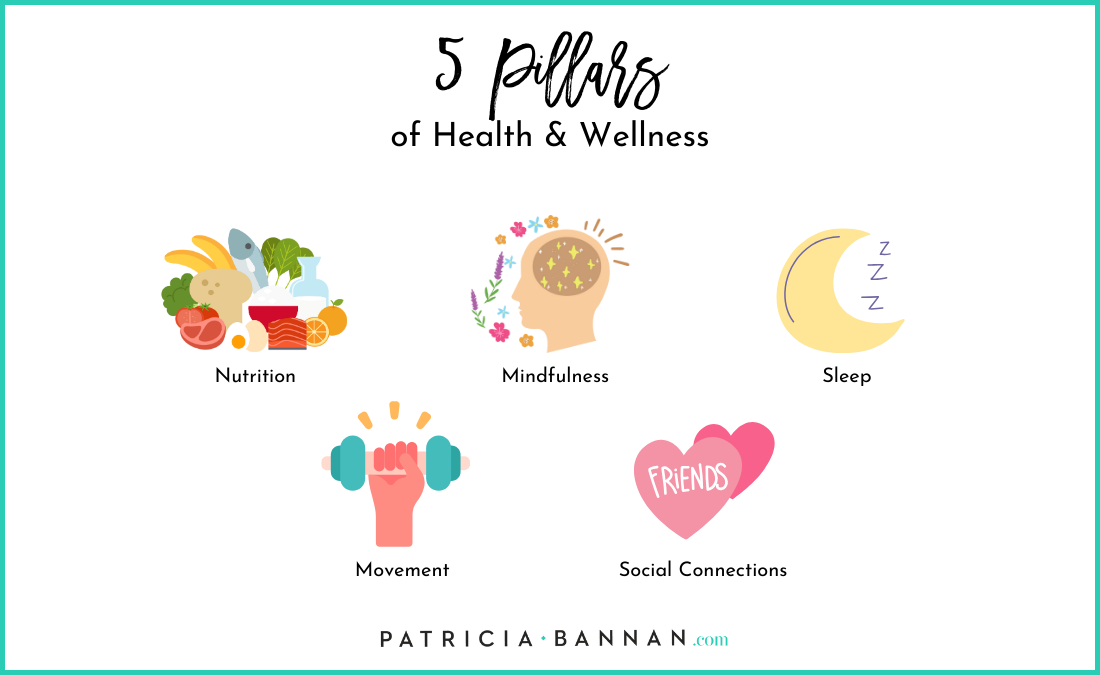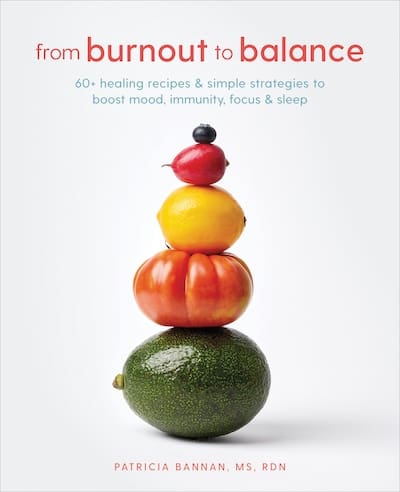Feeling burnt out and struggling to stay on a path of healthy living? Learn how to strengthen these five key pillars of health and wellness for a foundation for a joyful and healthy life.
To start, what are the pillars of health? Although health is often thought of as one general concept, it’s made up of several components known as the pillars of health. Each of the pillars is important on its own, and together, they help to keep your mind and body running optimally.
Neglecting just one can have an impact on your health, so it’s important to plan and implement small steps to improve each of these pillars of health and wellness. Let’s explore the five key pillars and how to prioritize them.
How Many Pillars of Health are There?
Though there are many elements that contribute to a healthy lifestyle, I’ve chosen to arrange them into five key pillars of health and wellness when working with my clients. You might find that there are additional parts of your life that aren’t listed below, and that’s okay! Also note that there may be sub-pillars that can fit into this structure as well.
Remember that each person’s journey to wellness is different—what matters most is ensuring that you approach it with your needs and health in mind.
What are the Five Pillars of Health?

- Nutrition
- Mindfulness
- Sleep
- Movement
- Social connections
Read on below to learn more about each of these five pillars of health and the steps you can take to strengthen them in your life.
1. Nutrition

Therefore, it’s important nourish your body with fiber, lean protein, and healthy fat for a balanced plate. This includes foods such as fruits and vegetables, legumes, nuts and seeds, fish, and lean meat.
Tips for Strengthening Nutrition as a Pillar of Health
- Start small: Changing your whole diet cam be overwhelming. Identify one aspect of your food habits or choices that you want to improve. Write down a small action you can take each day to prioritize this change.
- Prioritize protein: While high-sugar snacks might provide a quick energy boost, they often lead to crashes later on. Opt for high-protein alternatives to sustain energy levels throughout the day.
- Plan ahead: Create a permanent grocery list with your favorite staples. This will not only reduce burnout but also prevents you from resorting to less healthy takeout options. Consider implementing monthly meal planning strategies for additional guidance.
2. Mindfulness

Mindfulness is a crucial pillar of health and is often one of the most neglected. While it’s easy to overlook, there are small steps you can take to strengthen this pillar. With repetition and intention, mindfulness becomes more routine and easier to incorporate into your daily life.
Tips for Strengthening Mindfulness as a Pillar of Health
- Pause to reflect: Take one or two minutes every time you find yourself in between tasks—whether in the elevator, while looking in the mirror, or while waiting for a meeting to start—to reflect on how your day has been going and how you really feel.
- Keep a gratitude journal: Write down one thing every day that you’re grateful for. This practice improves awareness and serves as a great connector to the other pillars of health as well.
- Say a daily affirmation: Try one of these 20 Self-Love daily affirmations or write your own. It’s important to find one that really resonates with you or that you know you want to work on.
- Take a breath: It’ll calm your system, keeping you from constantly being in “go mode.”
3. Sleep

Lack of sleep can not only result in brain fog and hasten burnout, but it can also contribute to serious health problems down the road. Experts recommend that adults 7-9 hours of sleep each night.
While a perfect night’s sleep every night isn’t realistic, there are steps you can take to help achieve more optimal sleep. The most important thing to remember is that any small step towards balancing your pillars of health will strengthen the foundation under your feet and make the other pillars easier to achieve.
Tips for Strengthening Sleep as a Pillar of Health
- Minimize bedtime distractions: If you have loud noise, bright lights, or other distractions in your bedroom, your sleep might suffer. Try using earplugs or an eye mask to block them out and help you sleep soundly.
- Enjoy herbal tea before bed: Consider having a cup of chamomile tea or other relaxing alternative, such as one of these teas known for their soothing properties, before bed.
- Cut down on the caffeine: It’s a vicious cycle—you don’t get enough sleep, so you drink more coffee, so you don’t get enough sleep… and so on. Break the cycle, and your body will thank you!
4. Movement

- Help take your mind off stress,
- Improve circulation and digestion,
- Strengthen your body as a whole.
You don’t have to go all out, though—simply implement what dietitians call “exercise snacks,” or small bits of movement throughout the day to keep you active and healthy.
Tips for Strengthening Movement as a Pillar of Health
- Incorporate exercise snacks: Park further from the grocery store, take the stairs whenever possible, or stroll around your yard before bed. These small actions may not seem significant individually, but they add up over time. Consider getting a smartwatch to track your steps for added motivation and accountability.
- Messy dance: Movement doesn’t have to be pretty. If you can’t do the newest dance move or the proper Zumba choreography—who cares! Your body doesn’t—so turn up the music and dance around.
- Be creative and work with what you’ve got: For some ideas, check out these fun indoor activities for adults and kids, helping to get both you and your children active.
5. Social Connections

Even a quick voice message or letter can keep your relationships strong and help you feel connected and healthy. Remember, you’re never alone!
Tips for Strengthening Social Connection as a Pillar of Health
- Meet someone new: Whether that’s joining a new gym group, a book club, or volunteering, it can be refreshing to engage with someone you’ve never met before.
- Find new ways to hang out with old friends: Shaking up routines can strengthen connections and add excitement to your relationships.
- Remember the word “no”: Saying “no” is always an option. Too much social time can leave you feeling tired and spread too thin. Sometimes, recharging alone is the best option for self-care.
Putting it All Together
Remember, each of the five pillars of health need to be strong—you can’t be fully healthy on only a few hours of sleep every night, even if you’ve gone above and beyond in every other aspect.
Although this might sound daunting with a busy life, it’s a lot simpler than it seems. Once you start making small changes to your lifestyle—such as taking five minutes each day to be mindful and reflective—your steps to strengthening the other pillars will follow much more easily. Change might not happen overnight, but progress does!
If taking the first step still feels like an insurmountable task, let me guide you. Check out my book, From Burnout to Balance: 60+ Healing Recipes & Simple Strategies to Boost Mood, Immunity, Focus & Sleep, for tips, tricks, and inspiration.
References
- Steptoe A, Kivimäki M. Stress and cardiovascular disease. Nat Rev Cardiol. 2012;9(6):360-370. Published 2012 Apr 3. doi:10.1038/nrcardio.2012.45
- Kivimäki, M., Bartolomucci, A. & Kawachi, I. The multiple roles of life stress in metabolic disorders. Nat Rev Endocrinol19, 10–27 (2023). https://doi.org/10.1038/s41574-022-00746-8
- How Sleep Works – How Much Sleep Is Enough? | NHLBI, NIH. Published March 24, 2022. Accessed January 12, 2024. https://www.nhlbi.nih.gov/health/sleep/how-much-sleep






